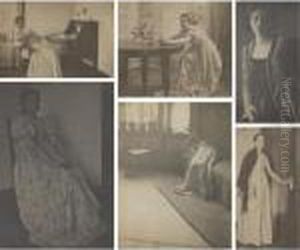Clarence Hudson I White Paintings
Clarence Hudson White was an influential American photographer born on April 8, 1871, in West Carlisle, Ohio. He gained recognition as one of the key figures in the pictorialist photography movement in the late 19th and early 20th centuries. White's work was characterized by its soft focus and emphasis on the beauty and artistic quality of the photographic image.
White's interest in photography began in his late teens, and he was largely self-taught. He initially worked in the insurance field to support his family, but his passion for photography led him to dedicate much of his spare time to the craft. White's early works, which often depicted rural life and simple, everyday scenes, stood out for their artistic composition and use of natural light.
In 1898, White gained national attention after his work was published in 'Camera Notes,' a prestigious photography journal edited by Alfred Stieglitz, who was a leading figure in the development of artistic photography. White's relationship with Stieglitz and other photographers led to his involvement with the Photo-Secession, a group that aimed to promote photography as a fine art rather than merely a documentary medium.
Throughout his career, White taught photography and influenced a generation of photographers. In 1914, he founded the Clarence H. White School of Photography in New York City, which was one of the first educational institutions in America to offer a program dedicated to artistic photography. The school attracted students from across the United States and abroad, and it continued to operate until a few years after White's death.
White's photographic style evolved over time, but he remained dedicated to the pictorialist aesthetic, emphasizing tonal variation, composition, and mood. He often employed long exposures and printing techniques that allowed for manipulation of the image, such as gum bichromate and platinum prints, which were popular among pictorialists for their range of subtle tones and surface texture.
Clarence H. White died on July 7, 1925, in Mexico City, Mexico, while on a photographic assignment. His legacy includes not only his photographic works, which are held in major museums and collections worldwide, but also his impact as a teacher and mentor to many who would carry the pictorialist tradition into the next generation. His contributions to the field of photography established him as one of the early American masters of the art form.
